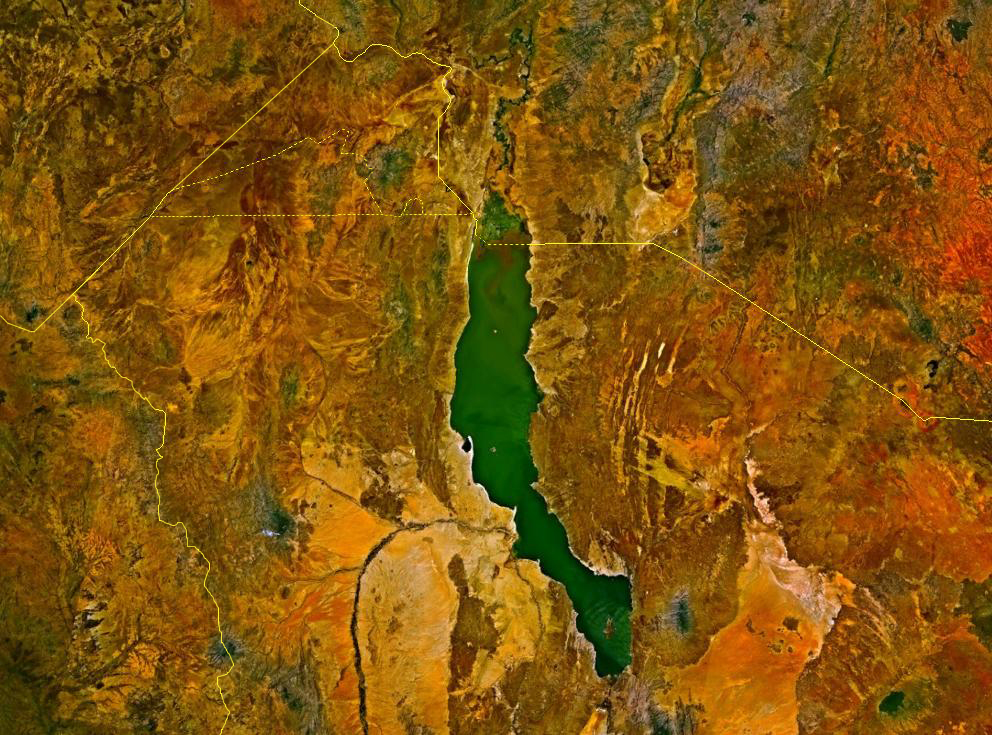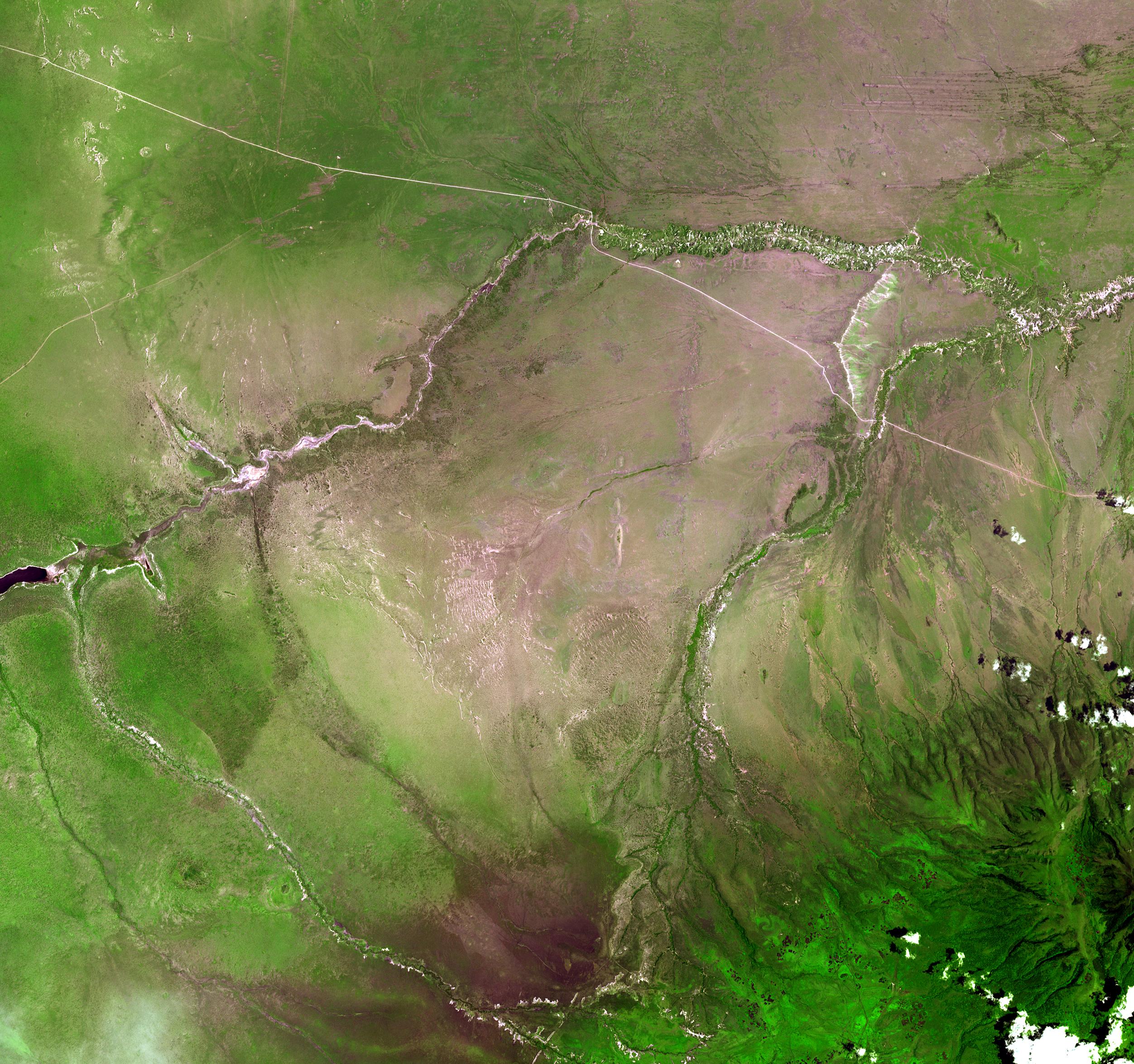|
Crocodylus Thorbjarnarsoni
''Crocodylus thorbjarnarsoni'' is an extinct species of crocodile from the Pliocene and Pleistocene of the Turkana Basin in Kenya. It is closely related to the species ''Crocodylus anthropophagus'', which lived during the same time in Tanzania. ''C. thorbjarnarsoni'' could be the largest known true crocodile, with the largest skull found indicating a possible total length up to . It may have been a predator of early hominins. ''Crocodylus thorbjarnarsoni'' was named by Christopher Brochu and Glenn Storrs in 2012 in honor of John Thorbjarnarson, a conservationist who worked to protect endangered crocodilians. Description ''Crocodylus thorbjarnarsoni'' is distinguished from other crocodiles by its broad snout. It has small raised rims on the prefrontal bones in front of the eyes, a feature also seen in some Nile crocodile individuals. The squamosal bones form raised rims along the sides of the skull table, similar to the crests in ''C. anthropophagus'' but much smaller. ... [...More Info...] [...Related Items...] OR: [Wikipedia] [Google] [Baidu] |
Pliocene
The Pliocene ( ; also Pleiocene) is the epoch in the geologic time scale that extends from 5.333 million to 2.58See the 2014 version of the ICS geologic time scale million years ago. It is the second and most recent epoch of the Neogene Period in the . The Pliocene follows the Epoch and is followed by the Epoch. Prior to the 2009 ... [...More Info...] [...Related Items...] OR: [Wikipedia] [Google] [Baidu] |
Skull Table
The skull roof, or the roofing bones of the skull, are a set of bones covering the brain, eyes and nostrils in bony fishes and all land-living vertebrates. The bones are derived from dermal bone and are part of the dermatocranium. In comparative anatomy the term is used on the full dermatocranium. Romer, A.S. & T.S. Parsons. 1977. ''The Vertebrate Body.'' 5th ed. Saunders, Philadelphia. (6th ed. 1985) In general anatomy, the roofing bones may refer specifically to the bones that form above and alongside the brain and neurocranium (i.e., excluding the marginal upper jaw bones such as the maxilla and premaxilla), and in human anatomy, the skull roof often refers specifically to the skullcap. Origin Early armoured fish did not have a skull in the common understanding of the word, but had an endocranium that was partially open above, topped by dermal bones forming armour. The dermal bones gradually evolved into a fixed unit overlaying the endocranium like a heavy "lid", protectin ... [...More Info...] [...Related Items...] OR: [Wikipedia] [Google] [Baidu] |
Rimasuchus Lloydi
''Rimasuchus'' is an extinct genus of crocodile from the Miocene of Egypt and possibly Libya. Only one species - ''Rimasuchus lloydi'' - is currently known. It was previously thought to be a species of '' Crocodylus'', but is now thought to be more closely related to the modern African dwarf crocodiles (''Osteolaemus''). History and naming The first fossil of ''Rimasuchus'' an incomplete skull with associated mandible, was collected by lieutenant colonel Arthur H. Lloyd in the early 20th century in Wadi Moghara, Egypt. The holotype specimen, CGM 15597, was given to the Egyptian Geological Museum and described by Fourtau in 1920 under the name ''Crocodylus lloydi''. Other material includes an uncatalogued skull housed at the Natural History Museum, London (likewise from Wadi Moghara) and fossils found at Gebel Zelten in Libya. Eventually other skulls further south in Africa ended up being assigned to ''"Crocodylus" lloydi'' , with the oldest and southern-most material stemming ... [...More Info...] [...Related Items...] OR: [Wikipedia] [Google] [Baidu] |
Lake Turkana
Lake Turkana (), formerly known as Lake Rudolf, is a lake in the Kenyan Rift Valley, in northern Kenya, with its far northern end crossing into Ethiopia. It is the world's largest permanent desert lake and the world's largest alkaline lake. By volume it is the world's fourth-largest salt lake after the Caspian Sea, Issyk-Kul, and Lake Van (passing the shrinking South Aral Sea), and among all lakes it ranks 24th. Lake Turkana is now threatened by the construction of Gilgel Gibe III Dam in Ethiopia due to the damming of the Omo river which supplies most of the lake's water. Although the lake commonly has been —and to some degree still is— used for drinking water, its salinity (slightly brackish) and very high levels of fluoride (much higher than in fluoridated water) generally make it unsuitable, and it has also been a source of diseases spread by contaminated water. Increasingly, communities on the lake's shores rely on underground springs for drinking water. The same c ... [...More Info...] [...Related Items...] OR: [Wikipedia] [Google] [Baidu] |
Koobi Fora Formation
Koobi is tilapia salted dried fish in Ghana. The fish has an indigenous flavor in stews and soup in the Ghanaian local delicacies. It is used to prepare Ghanaian foods such as fufu, soup, plantain and stew and other local Ghanaian cuisines. Preparation Koobi is processed by placing the fresh tilapia in a basin with salt in the fish chest. Use the salt to cover the fish for 3 days. After the 3 days, remove it and dry it in the sun for 5 days or until all the water is drained. See also * Ghanaian cuisine * Ghanaian people * Chop bar – a traditional eatery in Ghana, mostly located in Southern Ghana * West African cuisine West African cuisine encompasses a diverse range of foods that are split between its 16 countries. In West Africa, many families grow and raise their own food, and within each there is a division of labor. Indigenous foods consist of a number of ... * List of African cuisines * Cuisine References Fish dishes Ghanaian cuisine {{Ghana-cuisine- ... [...More Info...] [...Related Items...] OR: [Wikipedia] [Google] [Baidu] |
Lower Jaw
In anatomy, the mandible, lower jaw or jawbone is the largest, strongest and lowest bone in the human facial skeleton. It forms the lower jaw and holds the lower teeth in place. The mandible sits beneath the maxilla. It is the only movable bone of the skull (discounting the ossicles of the middle ear). It is connected to the temporal bones by the temporomandibular joints. The bone is formed in the fetus from a fusion of the left and right mandibular prominences, and the point where these sides join, the mandibular symphysis, is still visible as a faint ridge in the midline. Like other symphyses in the body, this is a midline articulation where the bones are joined by fibrocartilage, but this articulation fuses together in early childhood.Illustrated Anatomy of the Head and Neck, Fehrenbach and Herring, Elsevier, 2012, p. 59 The word "mandible" derives from the Latin word ''mandibula'', "jawbone" (literally "one used for chewing"), from '' mandere'' "to chew" and ''-bula'' (ins ... [...More Info...] [...Related Items...] OR: [Wikipedia] [Google] [Baidu] |
Skull
The skull is a bone protective cavity for the brain. The skull is composed of four types of bone i.e., cranial bones, facial bones, ear ossicles and hyoid bone. However two parts are more prominent: the cranium and the mandible. In humans, these two parts are the neurocranium and the viscerocranium ( facial skeleton) that includes the mandible as its largest bone. The skull forms the anterior-most portion of the skeleton and is a product of cephalisation—housing the brain, and several sensory structures such as the eyes, ears, nose, and mouth. In humans these sensory structures are part of the facial skeleton. Functions of the skull include protection of the brain, fixing the distance between the eyes to allow stereoscopic vision, and fixing the position of the ears to enable sound localisation of the direction and distance of sounds. In some animals, such as horned ungulates (mammals with hooves), the skull also has a defensive function by providing the mount (on the front ... [...More Info...] [...Related Items...] OR: [Wikipedia] [Google] [Baidu] |
Holotype
A holotype is a single physical example (or illustration) of an organism, known to have been used when the species (or lower-ranked taxon) was formally described. It is either the single such physical example (or illustration) or one of several examples, but explicitly designated as the holotype. Under the International Code of Zoological Nomenclature (ICZN), a holotype is one of several kinds of name-bearing types. In the International Code of Nomenclature for algae, fungi, and plants (ICN) and ICZN, the definitions of types are similar in intent but not identical in terminology or underlying concept. For example, the holotype for the butterfly '' Plebejus idas longinus'' is a preserved specimen of that subspecies, held by the Museum of Comparative Zoology at Harvard University. In botany, an isotype is a duplicate of the holotype, where holotype and isotypes are often pieces from the same individual plant or samples from the same gathering. A holotype is not necessarily "typ ... [...More Info...] [...Related Items...] OR: [Wikipedia] [Google] [Baidu] |
National Museum Of Kenya
The National Museums of Kenya (NMK) is a state corporation that manages museums, sites and monuments in Kenya. It carries out heritage research, and has expertise in subjects ranging from palaeontology, archeology, ethnography and biodiversity research and conservation. Its headquarters and the National Museum ( Nairobi National Museum) are located on Museum Hill, near Uhuru Highway between Central Business District and Westlands in Nairobi. The National Museum of Kenya was founded by the East Africa Natural History Society (E.A.N.H.S.) in 1910; the society's main goal has always been to conduct an ongoing critical scientific examination of the natural attributes of the East African habitat. The museum houses collections, and temporary and permanent exhibits. Today the National Museum of Kenya manages over 22 regional museums, many sites, and monuments across the country.NMK, "National Museums of Kenya," 2006-03-31, Museums.or.ke, webMuseumsOR/ref> Nairobi National Museum of K ... [...More Info...] [...Related Items...] OR: [Wikipedia] [Google] [Baidu] |
Greek Language
Greek ( el, label=Modern Greek, Ελληνικά, Elliniká, ; grc, Ἑλληνική, Hellēnikḗ) is an independent branch of the Indo-European family of languages, native to Greece, Cyprus, southern Italy (Calabria and Salento), southern Albania, and other regions of the Balkans, the Black Sea coast, Asia Minor, and the Eastern Mediterranean. It has the longest documented history of any Indo-European language, spanning at least 3,400 years of written records. Its writing system is the Greek alphabet, which has been used for approximately 2,800 years; previously, Greek was recorded in writing systems such as Linear B and the Cypriot syllabary. The alphabet arose from the Phoenician script and was in turn the basis of the Latin, Cyrillic, Armenian, Coptic, Gothic, and many other writing systems. The Greek language holds a very important place in the history of the Western world. Beginning with the epics of Homer, ancient Greek literature includes many works of lasting impo ... [...More Info...] [...Related Items...] OR: [Wikipedia] [Google] [Baidu] |
Olduvai Gorge
The Olduvai Gorge or Oldupai Gorge in Tanzania is one of the most important paleoanthropology, paleoanthropological localities in the world; the many sites exposed by the gorge have proven invaluable in furthering understanding of early human evolution. A steep-sided ravine in the Gregory Rift, Great Rift Valley that stretches across East Africa, it is about long, and is located in the eastern Serengeti Plains within the Ngorongoro Conservation Area in the Olbalbal ward located in Ngorongoro District of Arusha Region, about from Laetoli, another important archaeological locality of early human occupation. The British/Kenyan paleoanthropologist-archeologist team of Mary Leakey, Mary and Louis Leakey established excavation and research programs at Olduvai Gorge that achieved great advances in human knowledge and are world-renowned. The site is registered as one of the National Historic Sites of Tanzania. The gorge takes its name from the Maasai language, Maasai word ''oldupai'' ... [...More Info...] [...Related Items...] OR: [Wikipedia] [Google] [Baidu] |







